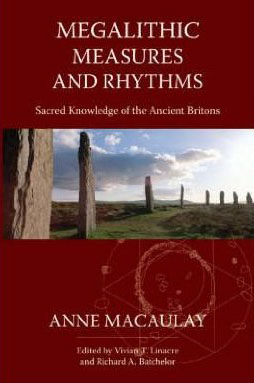 … Sacred knowledge of the Ancient Britains
… Sacred knowledge of the Ancient Britains
Synopsis from (from book cover):
The huge stone circle built in the British Isles and northwest France from 6500 to 3500 years ago are among civilisation’s strangest monuments. Ignored or plundered for centuries, they have only in modern times begun to reveal their remarkable complexity.
It is now widely acknowledged that these ancient sites were precisely aligned to major celestial events, probably lined to the agricultural calendar of early farming settlements. But the mystery remains as to how the megalithic builders achieved such extraordinary accuracy in their measurements and construction.
Inspired by the surveying work of Alexander Thom, Anne Macaulay devoted her life to an investigation of the stone circle sites, seeking out their hidden geometry and deeper cultural significance. In this book she draws on ideas from geometry and metrology, archaeology and anthropology, history and mythology, astronomy and music.
Macaulay concludes that the extraordinary mathematical skills of the ancient Britains were original and self-contained. In turn, the elite of this society became the proto-Greeks, their knowledge flowing to the Eastern Mediterranean.
Review:
Anne Macaulay’s life work was collated by Vivian T. Linacre and Richard A. Batchelor and published posthumously.
The first part the book covers the geometry of megalithic rings throughout Great Britain and Northern France. The measurements that Anne took are compared with the original measurements taken by Alexander Thom. Her work shows how the ancients had advanced mathematical knowledge and that the stone circles were measured out based on Fibonacci numbers.
In his works Thom proposed that two ancient measurements were used in the making of the megalithic rings; The Megalithic Yard and the Megalithic Rod. Anne introduces I third measurement, The Greek Foot. She further proposes that measuring sticks (ancient rulers) were used to measure out the sites and that this knowledge seemed to have died out after the megalithic era and was later rediscovered later by Leonardo of Pisa.
Anne thought that the transition from hunter gatherer to a settled farming community led to the requirement for astronomical and geometrical skills for forecasting the seasons and measuring boundaries and suggested that these skills were taken from Britain and the Atlantic to the Eastern Mediterranean.
It is a thoroughly fascinating book and I would recommend it to anyone who is interested in the subject.








The most fascinating part of the book is section 2.
Some good books listed in the bibliography also; Keith Critchlow’s and John Neal’s in particular.
Section 2 is interesting. The migrations are in reverse from other books I have read…
I have John Neal’s book, I sourced a copy a while ago when you recommended it
Thank you for the recommendation, Cherie. Just the sort of book I would give to my youngest son, and then borrow back!
I hope you both enjoy it, if you decide to do that.